Ideal projector and projector screens for houses of worship
Making a purchase for your church is a thoughtful process as you are preparing to show media in the best possible way to your viewers.
This guide is designed specifically to show you how to select a projector that congregation will enjoy, plus give you some cost-saving tips to make sure you stay within your budget.
We hope you’ll find this guide on how to choose the best projector and projector screen helpful. Let’s look at the most important element to kick things off: how you’re actually going to be using that brand new projector.
How Will You Use It?
Many churches like to look at just the sanctuary when figuring out how to select a projector, but smaller ministries within your community will want to use the new projector when it arrives. Thinking about these ministries and the different groups at your church may help you understand different requirements.
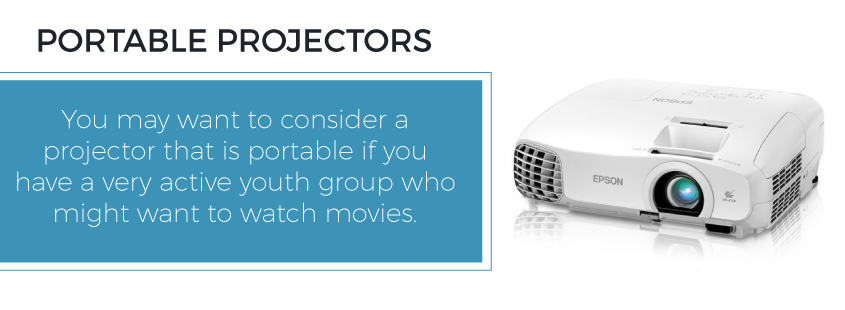
You may want to consider a projector that is portable if you have a very active youth group who might want to watch movies, if your Bible study likes to include audio-visual elements in their discussions or if you use would use the projector to make announcements outside of services.
When you’re setting a budget, look at projector and screen prices including the number of screens you’ll be purchasing as well. Start with the entire equipment list before you start pricing individual elements and you’ll be able to make most out of working with our projector screen online store.
Screen Size and Shape
Part of learning how to pick a projector starts with understanding the size of your space and the screen sizes you’ll be using. Look for screens that are designed to be used at the distance where you’re operating, plus those that are large enough so everyone can see.
If you’ve got a large or uniquely sized space, we recommend using our viewing distance calculator, which will help you select the screen size for each application as well as the right projector to meet those demands.
While size is best determined with that unique measurement, the shape of the screens you choose is often best determined by the content you’ll be showing.
Square
For standard projectors that are presenting information to the congregation in close quarters or in data formats, you’ll do well with a square format projector screen. The square shape means you’ve got a height ratio that’s typically 1:1 — or can support that format without image loss.
Square screens are common for overhead projectors and slide presentations in small spaces, so they can be great if you’re using this more for information like presenting the budget to your board. If you want a larger screen to showcase your daily readings, bulletin, program or song lists, you may want to look at another shape that’s friendlier to higher-quality images.
Video Format (4:3)
If you have content that’s shot in widescreen format — such as showing video of a recent mission trip — but are also broadcasting elements of your bulletin or special music, a video format screen shape could be right for your church. This is the resolution that most of us grew up with on TV, and it works well for both widescreen and full-screen viewing.
Video format screens and content also tend to do well when you’re trying to make sure the text is large and easy for everyone to read, whether they’re far in the back or may have trouble seeing in the front.
HD-Quality
Your HDTV uses a width-to-height ratio of 16:9, and this screen ratio is perfect for watching movies and other videos. It tends to perform best with moving content but may make it slightly more difficult than some other formats to show static images, such as a prayer for everyone to follow.
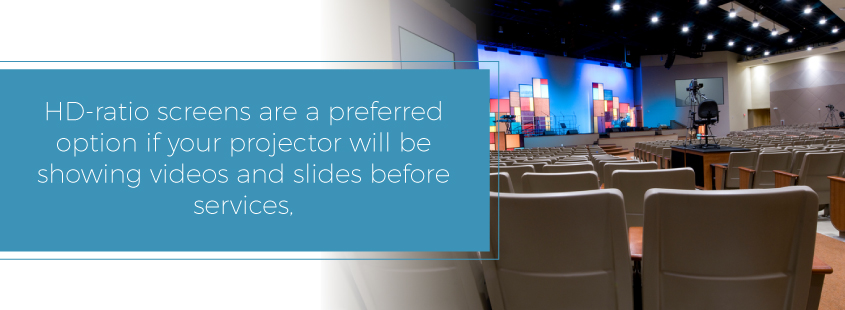
HD-ratio screens are a preferred option if your projector will be showing videos and slides before services, during special celebrations or with certain ministries like the youth group.
Help Me!
Many churches we work with end up having a congregation and needs that land them somewhere in the middle of these options. There are some specialty screens you can consider, and our online support staff can also help you make the right selection. Use our online chat option to ask questions and make sure you’re getting the right screens.
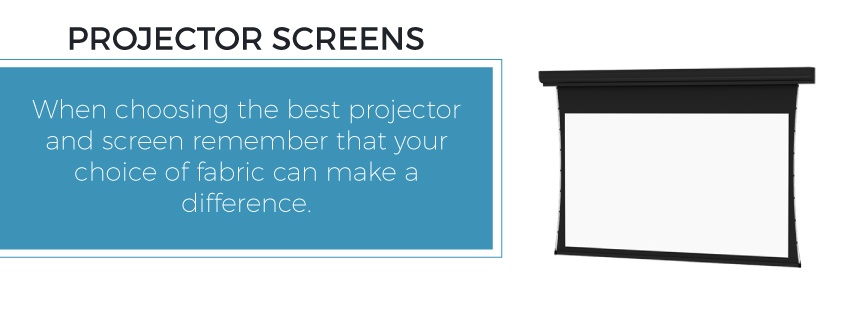
Projector Screen Fabrics
One of the surprises many people face when figuring out how to choose the best projector and screen is the fact that your choice of fabric can make a difference. When you start looking at fabric, it can all feel a little overwhelming because new terms and words will be introduced, often without much clarity. This section will help you make the best decision by creating some understanding.
Gain
Different screen fabrics will perform differently based on the media you’re using, the lighting in the room, how the audience is sitting and even the sound that’s present.
Gain is the first characteristic you’ll want to figure out. Gain is a measurement of how much light the screen reflects from the projector. The standard gain tends to be 1, and that means all light being directed at the screen is reflected back at the same brightness.
However, gain is impacted by the ambient light of the projected image and the room. The brighter it is in the room, the more the reflected light will dissipate and the image will be washed out. The opposite is true, so the darker the room, typically the better the image quality.
Other important things to know:
- Gain greater than 1: This means the projection screen fabric can actually increase the brightness of the image that’s being shown back to the audience.
- Bright rooms: You’ll typically want to go with a higher gain if your room is well-lit during use or if you can’t control the ambient light very well. This means most church services will need a screen with high gain because the projector itself can’t put out enough light to meet environmental demands.
Now, it’s important to remember that as gain increases, viewing angle will typically decrease slowly.
Viewing Angle
The viewing angle is a measurement of the distance from the center of the screen to the point where you can see the same quality image as you move further down the viewing axis. This is important to consider because some projection screens will reflect more light perpendicular to the screen and less light to the sides, making the screen look darker when the viewer isn’t in the optimal viewing angle.
To learn more about all your screen material options and to get help selecting the right viewing angle, check out this complete guide to different screen surfaces from the manufacturers we carry.
Now let’s start talking about your projector.
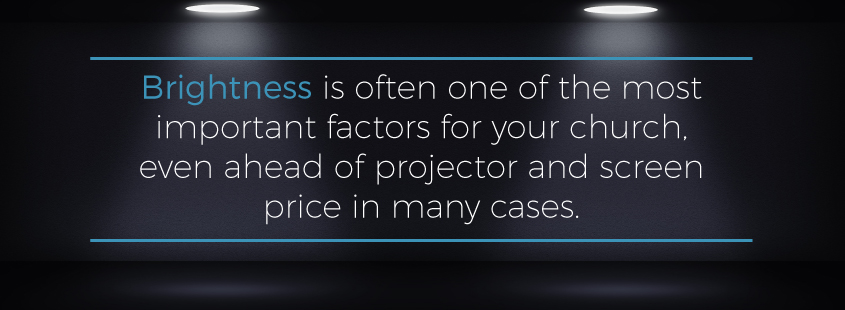
Projector Brightness
Brightness is often one of the most important factors for your church, even ahead of projector and screen price in many cases.
Churches we work with tend to either be very bright with much natural light during their services or relatively muted spaces when it comes to light — so there is little natural light and most additional lighting is soft. This creates different requirements for a projector.
To see how to pick a projector, you’ll need to go and sit in the pews and observe your normal lighting settings. If your church is bright and has limited control over the overall brightness or cannot dim the lights, you will likely need a bright projector that is able to cope with large amounts of ambient light.
If your setting is dark, you can pick a projector with a lower brightness setting in order to prevent washing out the image or making the screen too bright to comfortably read in your darker space.
Projectors we recommend for churches will typically range from 2,500 to 8,000 lumens, based on the lighting scenario and how many people your church fits. For small churches — those of 100 people or fewer — in a bright room, you should start with a projector at 2,500 lumens. This also fits for slightly larger churches if the room is especially dark.
If your congregation is closer to 150 people, we recommend increasing the strength to 4,000 to 5,000 lumens based on whether your room is darker or brighter. If your congregation exceeds 250 people, we suggest you start with at least 6,000 lumens for bright rooms — if your space is very large and people have a lot of legroom, you may want to start closer to 7,000 or 8,000 lumens to ensure your projector is bright enough for everyone to see clearly.
While 5,000 lumens is a common starting point, we really do recommend you start by speaking with representatives of our projector screen online store for free to discuss your space. There are a lot of special considerations you may not be aware of and we can’t fully cover here in this post.
If you have a darker room or you’re able to better control the ambient light and make it darker when you plan to use the projector, you should be able to save your church some money by selecting a projector with a lower lumens rating and pairing it with a screen that has a higher gain.
Contrast Ratio
Another specification you’ll probably see touted a lot by projector screen online stores is the contrast ratio of the projector. This isn’t too big of a factor for most churches, but it deserves a little bit of attention. The contrast ratio tells you the difference between a pixel that is “fully on” and one that is “fully off” in terms of brightness.
The higher the ratio, typically the brighter it is between a white color and the projector’s attempt to create a black color. Because of the way projectors work, some light will leak over to the “off” pixels, preventing them from being truly black. A good example is a 1000:1 contrast ratio, which means a fully on pixel is about 1,000 lumens brighter than your “off” pixel.
The higher the contrast on a projector, the better the depth of color, so you see more subtlety between different colors and variations of the same color. This will make textures and other elements clearer and keep your darker scenes from looking too washed out.
We typically will tell churches trying to figure out how to select a projector that they don’t need to worry about very high contrast ratios. That’s because you’re usually not adding complex textures or color options to music, announcements and other content. Some of this color depth will also be lost on the folks in the back if you have a very large church — a lower contrast ratio will still deliver a fine image that’s easy to read.
The only time we think you should carefully consider a higher contrast ratio is if you’re planning on doing a lot of movie nights or showing a lot of video.
Mounting or Standing
Modern churches are found in all kinds of buildings, so there is no single catch-all recommendation for the mounting type of your projector. Clients come to us with buildings that are more than 100 years old to brand new chapels, converted homes, office space rentals, hotel ballrooms and much more.
The face of the modern church building is changing, but thankfully our projectors are flexible enough to accommodate those changes.
If your church would fit with what most of us picture in our minds as an old-fashioned church building, you might want to look at a custom mounting solution or a portable projector. High ceilings can make some standard mounts more difficult or inaccessible. The taller your ceiling and higher your mounting position, the more likely you are to have to find a specializing mounting for your specific drop.
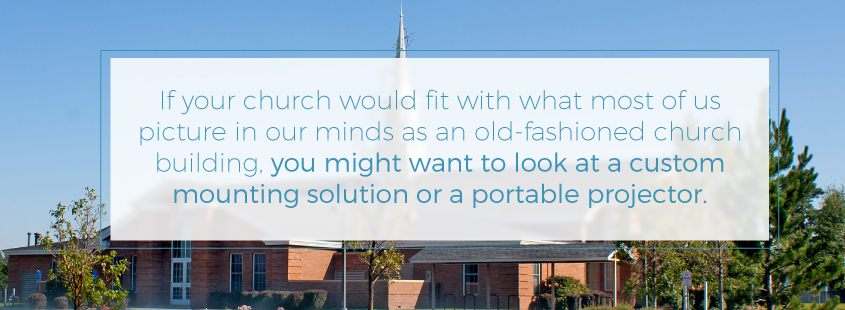
In those cases, it actually may be more prudent and cost effective to purchase a high-end portable projector that can be placed on a pedestal and directed to your screen. Portable screens are also a must if your church rents space for its worship services or if you plan on using the projector in multiple rooms.
If you’ve got the space and want a fixed projector, you can also consider a rear projection unit. This will require some additional space on a wall behind your screen but may be a way to have a hidden unit. Rear-projection setups also tend to do better in places with more light. However, we will note that rear-projection units can be more expensive than their front-projection counterparts.
Help on How to Pick a Projector
That all can be a little overwhelming, and it probably gave you a lot more to consider than you were thinking. We know that’s often the case because many of the people buying projectors for their churches aren’t audio-visual professionals — they’re people trying to be the best steward of church finances while making their worship services more enjoyable.
We completely understand that churches today have a strict budget with a specific amount allocated for this purpose. At the Projector Screen Store, we’ll respect your projector and screen price requirements while making suggestions that will give churchgoers the best experience.
To help you choose the best projector, we recommend that you contact us directly. You can use the online support tool found on any of our pages or call us toll-free at 800-637-3181. We’ll make recommendations based on your space and even help you figure out how to do some of the measurements if you’re still in the buying process. We’ve got a lot of great tools in our Knowledge Base right now, whether you need help with distance calculations, screen buying guides or details on screen sizes.
We at the Projector Screen Store hope you’ve found this guide helpful and are here to answer any of your questions and concerns. We look forward to hearing from you and helping you have wonderful services and celebrations with the perfect projector.